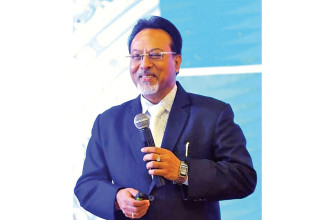
Despite its low carbon emissions, Nepal is one of the countries being severely affected by the global temperature rise. This will pose manifold challenges in the lives of people and the economy as cultivation of crops could be affected, water-flow in the river basin could be irregular, and the melting of Himalayas and glacial lakes raise the possibility of nature induced disasters as well as scarcity of drinking water, and problems of irrigation and hydropower.
In this context, Nepal will propose to take the lead for conserving the Himalayas which spread over the Hindu-Kush region. In the United Nations’ 26th Conference on Climate Change (COP-26), Nepal will raise the issue of ‘Himalayas at Risk’. The Himalayas of the Hindu-Kush region are serving 1.9 billion people on earth and the global community should give proper attention and be ready to support this region generously recognising the fact that the risk is triggered due to the disaster-prone nature of the youngest mountains because of climate change.
Business 360 caught up with Saloni Pradhan Singh, Member of the National Planning Commission – the apex planning body of the government – to learn what will be Nepal’s statement and what issues will be raised at the COP-26 Global Leaders Conference, where Prime Minister Sher Bahadur Deuba will represent the Nepali delegation on November 1 in Glasgow of Scotland, the fourth-most populous city of the United Kingdom and 27th largest city by population in Europe.

Countries worldwide are saying the 26th Conference of United Nations on Climate Change is important and will create a benchmark on climate change issues. Why is COP-26 significant for Nepal?
COP-26 is significant for Nepal as we lie in between highly populous and powerful countries. Both our neighbouring giants have an important role to play to achieve the global targets on climate change mitigation. We are sensitive as our northern belt is covered by the snow-capped Himalayas and global warming causes severe impact on those Himalayas mainly melting of the Himalayas and glacial lakes. It might cause multiple nature-induced disasters and manifold challenges in our hydropower sector, irrigation, drinking water network, among others. Secondly, our geography slopes from the north to south, and the floods and erosion take away the minerals of the soil to the southern belt. Our socio-economic and cultural and political influence can be seen from both our neighbours. I would rather say, not only green environment, we are living in a grey environment because of the influence of both the neighbouring giants. We have the world’s highest mountain peak, Mt Everest, and we have to preserve our Himalayas. In this regard we must be sensitive and raise issues caused by climate change during COP-26 and this is the only forum to draw the attention of the global community towards the issues we are facing and look forward to a solution-oriented cooperation.A global temperature rise of two degree fahrenheit has been causing erratic climatic conditions. You have highlighted the manifold impacts that this have been having. In this context, how can the least developed countries which are more vulnerable and lack resources establish their voice at global forums?
We cannot do it alone. We have to build a partnership with countries facing similar issues. Definitely, we have to collaborate with the LDCs and nations that have been facing and advocating on similar issues. We have to adopt effective strategies to establish our voice and seek cooperation.In the past, there was commitment of carbon trade based on the exposure of carbon emissions of respective countries. Why has this concept not been able to function effectively?
We are doing homework on this. Nepal also has approved long-term zero carbon emission strategy by 2030. The long-term strategy entails internalising issues in our policies and programmes, resource mobilisation, cooperation, research and development and others. To have net zero emissions, we need resources worth $50 billion in the next decade. We are going to claim compensation for losses we have faced so far. The global community should forge consensus to ensure cooperation for countries like us adopting net zero emissions mission. Those with high exposure to carbon emissions should support countries that have less exposure and adopt net zero emissions measures.
Do you believe countries with high exposures will go through such negotiations?
I can’t say about the current dynamics. It can change at the last minute. Powerful countries have greater clout, that is why we should also make our advocacy and alliance bigger, stronger and more strategic. We should form an alliance with nations facing similar issues. Negotiations will depend on how stronger and strategic our alliance will be and how effectively our diplomacy can deal with countries with high carbon emissions.There was a dilemma on taking forward issues of climate change as global power, the United States, had opposed the idea during former President Donald Trump’s tenure. And this time too some other countries are reportedly lobbying to change the Intergovernmental Panel on Climate Change (IPCC)’s report on climate change. What is your opinion?
It is obvious that the erring countries will try to save their face, and moreover, they are rich and powerful and will try to influence others. We have to anticipate that these countries could form an alliance at different platforms for their benefit. It is said that Donald Trump lost the elections because of his wrong advice and reaction on climate change issues. Even now, many countries are not willing to end their dependency on coal and adopt renewable, clean and green sources of energy. In fact, the global community should realise that no one can be safe unless we ensure everyone is safe.The Net Zero Emissions Strategy of Nepal has identified the need for $50 billion to be mobilised in the next decade. Where should we make major investments - in energy or another sector?
We have to make investments in various sectors of climate mitigation and adaptation strategies. We have foundations to execute net zero emissions strategy as we have clean, green and renewable sources of energy and we have to exploit the potential without harming the environment to replace the use of fossil fuels and biofuel. For this, we have to stress massive electrification. On the other hand, we have massive forest coverage at around 45% of the country. We are the pioneer in community forestry (local participation for forest management) in South Asia. We have initiated the Local Adaptation Plan of Action (LAPA) and mitigation strategies. We have envisioned to promote electric vehicles by minimising tax rates and it is similar to electric stoves. We will have surplus energy in the near future and we are doing the groundwork to export that surplus power. We can develop a model on this front. We have been taking relevant local adaptation and mitigation measures. That is our strength, which we can show to the world.The Net Zero Emissions Strategy needs to be internalised in the national plans and programmes. What are you doing on this front?
This must be included and prioritised in every plan, policy and cross-cutting area. As the apex planning body, we will formulate the plan and we are the authority to approve the projects and programmes recommended by the ministries. We will also coordinate with the provincial and local levels. There are common agendas and responsibilities at all three tiers of the government and there are also challenges to consolidate and coordinate with them. As required there will be effective plans, policies, programmes and institutions in place for the effective execution of the strategy. Simultaneously, we must focus on policies and institutional reforms to make them function effectively.We have been facing multiple challenges and we can foresee more challenges ahead. Our geopolitical set up itself is a challenge and demography is changing to an ageing society. Our topography also is challenging though it is our beauty too. Our cropping and agricultural pattern is one of the challenges as we are cultivating in sloping lands and minerals (nutrients) of the soil are being swept away to the south as soil erosion is high.
You have highlighted the vulnerability of the Himalayas due to climate change. The Hindu-Kush region has encountered similar issues. What sort of cooperation must we form to tackle climate change issues?
Definitely, regional cooperation is a must. We have been hosting ICIMOD (The International Centre for Integrated Mountain Development) for long. At COP-26, we will be highlighting that ‘Himalayas and Mountains are Pulse o°f the Planet’ and we will seek specific attention on the Himalayas that are at risk. The impact of the risk is everywhere but we have been directly facing unpredicted hazards. For example, from July this year, we have been facing unpredicted disasters, colossal losses of development projects, properties as well as the loss of lives. The done and dusted Melamchi Water Supply Project’s source river is buried under a landslide. In recent days, farmers have faced huge losses of major crops due to prolonged erratic monsoon in the paddy harvesting season. We have to control the warming to save our Himalayas which is the source of the water that flows in the river basins and natural habitats of the Hindu-Kush region which serves 1.9 billion people of the earth. The COP-26 should pay due attention to this. Our net zero emissions strategy has envisioned to stabilise temperature at 1.5°c, which is important and the global community should recognise this and provide necessary support. We’re developing clean energy and we can help the region to lower carbon emissions through the use of clean, green and renewable energy. We have the potential for carbon trading as we have been developing clean and renewable energy and conserving the environment and we should be duly acknowledged.You have talked about initiating local adaptation and mitigation plan of action, however we are weak in research and development. How can we formulate effective strategies and plans without proper R&D?
This is a relative aspect. Research and development are being carried out continuously, though it must be expanded and updated as climate change issues are sporadic and change frequently. We must be contextual and time-specific. We need to have an early warning system and reliable meteorological predictions. We must be well equipped and efficient. For example, if we had such meteorological prediction, farmers would have been able to harvest paddy on time before the floods and inundation wouldn’t have caused colossal loss of their production that is caused by the torrential rains. We still do not have any mechanism for early warning to ensure readiness in areas that could be affected to minimise the losses. Though we have a forecast that the monsoon could be erratic we must also have a programme simultaneously to minimise the losses rather than leaving people at the mercy of nature. We do provide relief after the disasters destroy the farms, homes and make people homeless but relief is just patchwork. We need to identify the cause and intensity to narrow down the losses and revive the lives of those who suffer due to such natural disasters. We have to gear up our efforts to combat climate change issues. One of the important factors is we should not only be relying on expert views, it must be blended with local experience and interfaced with the challenges. We must support people and communicate their views and pain to policymakers. Then only will local mitigation and adaptation measures are more representative and relevant to the people as per their biodiversity and natural habitat which is distinct within a single rural/municipal level. We should also pay attention to mobilising the youth on climate issues. Nepal is planning to graduate from the least developed status by 2022 but we have to do a lot for physical development especially infrastructure. In this context, the climate issues will raise the cost of development and it will also be more difficult for Nepal to expedite development activities as we are facing challenges of demography along with climate issues. We have been facing multiple challenges and we can foresee more challenges ahead. Our geopolitical set-up itself is a challenge and demography is changing to an ageing society. Our topography also is challenging though it is our beauty too. Our cropping and agricultural pattern is one of the challenges as we are cultivating in sloping lands and minerals (nutrients) of the soil are being swept away to the south as soil erosion is high. Siltation is high as our rocks are younger and life of hydropower turbines is too short in our case. It is because we can’t control siltation. As a country with the youngest and most fragile mountains, we have to be more sensitive and careful as I do see wrong practice of constructing local roads along steep mountains without proper engineering and environmental studies by the rural/municipal level. Despite being a labour-intensive country, we are doing capital intensive nature of work, by using excavators. The road track becomes like an irrigation canal during the rains as mud and boulders are swept away. We have a very short period of transition to an ageing society and we need a collaborative and cooperative approach for the development and conservation of nature. READ ALSO:
Published Date: November 15, 2021, 12:00 am
Post Comment
E-Magazine
RELATED Face 2 Face





